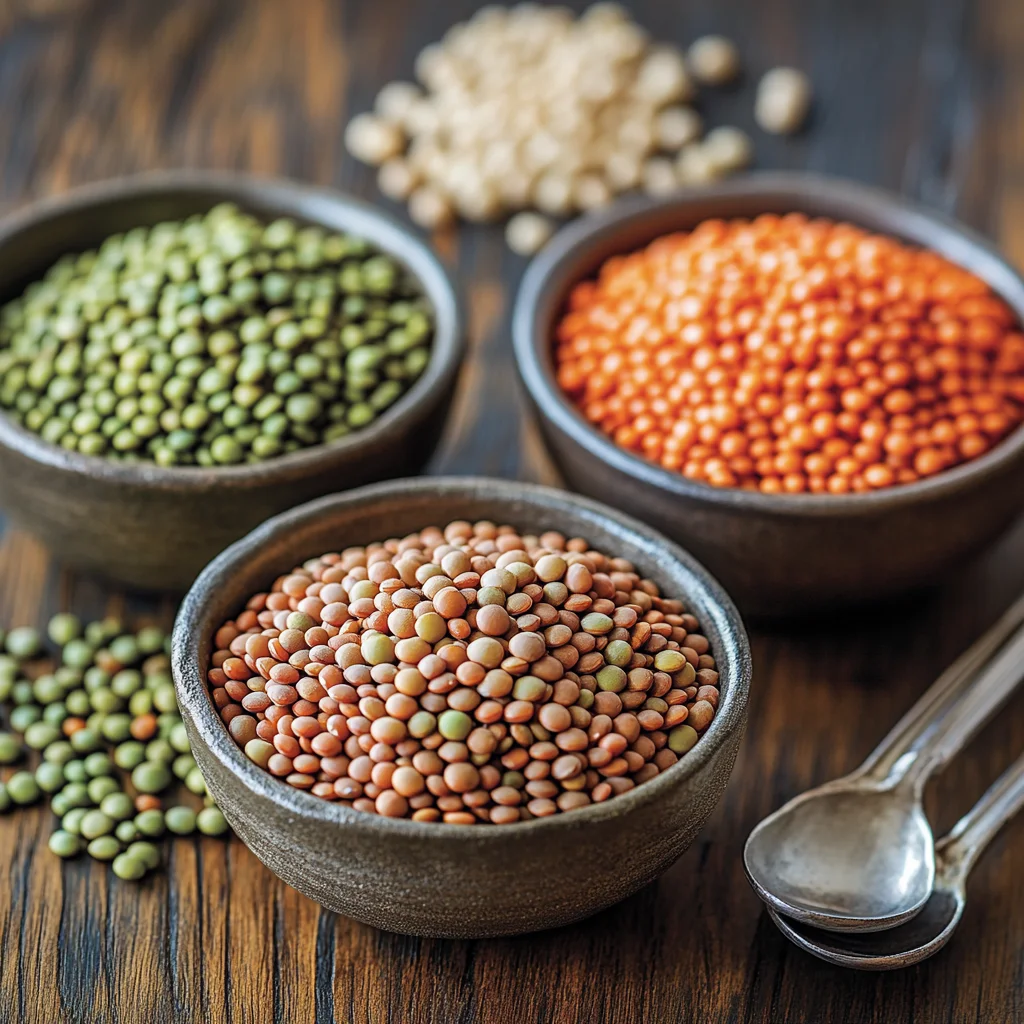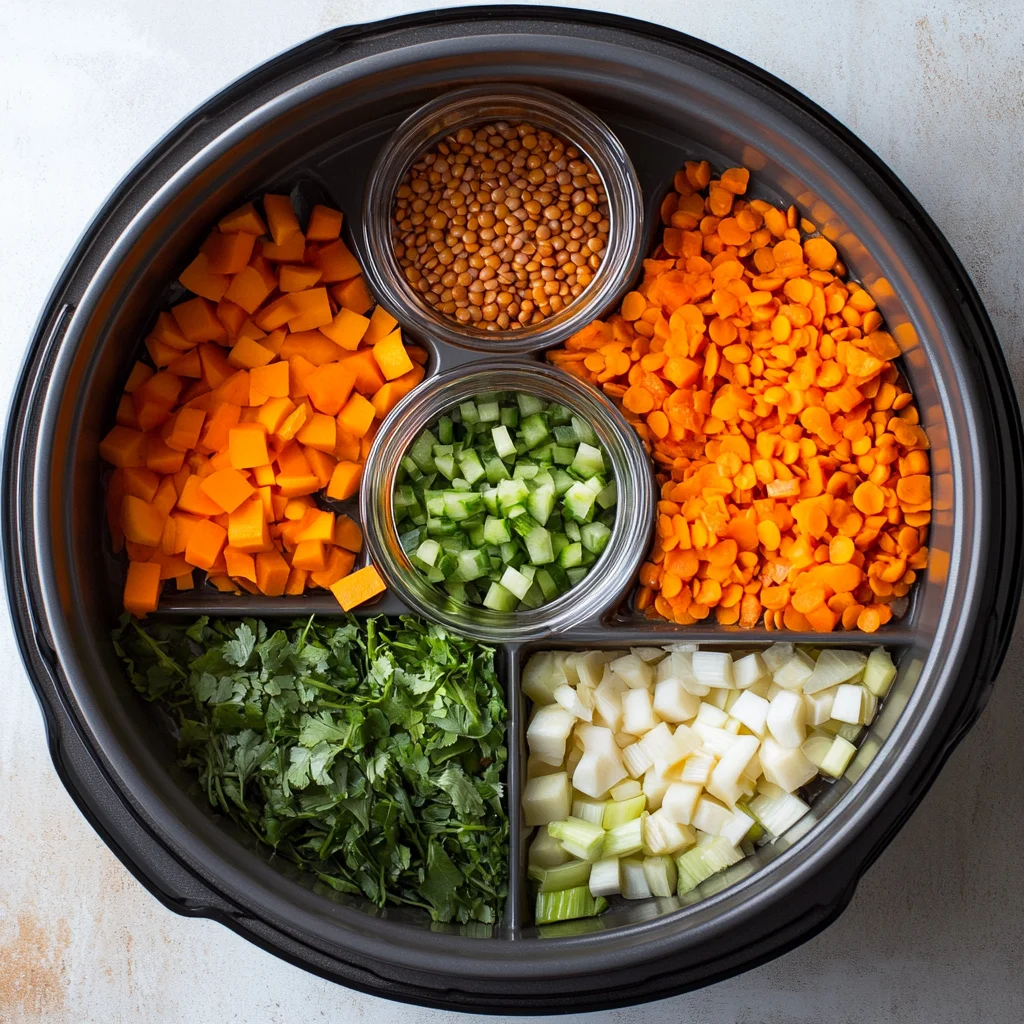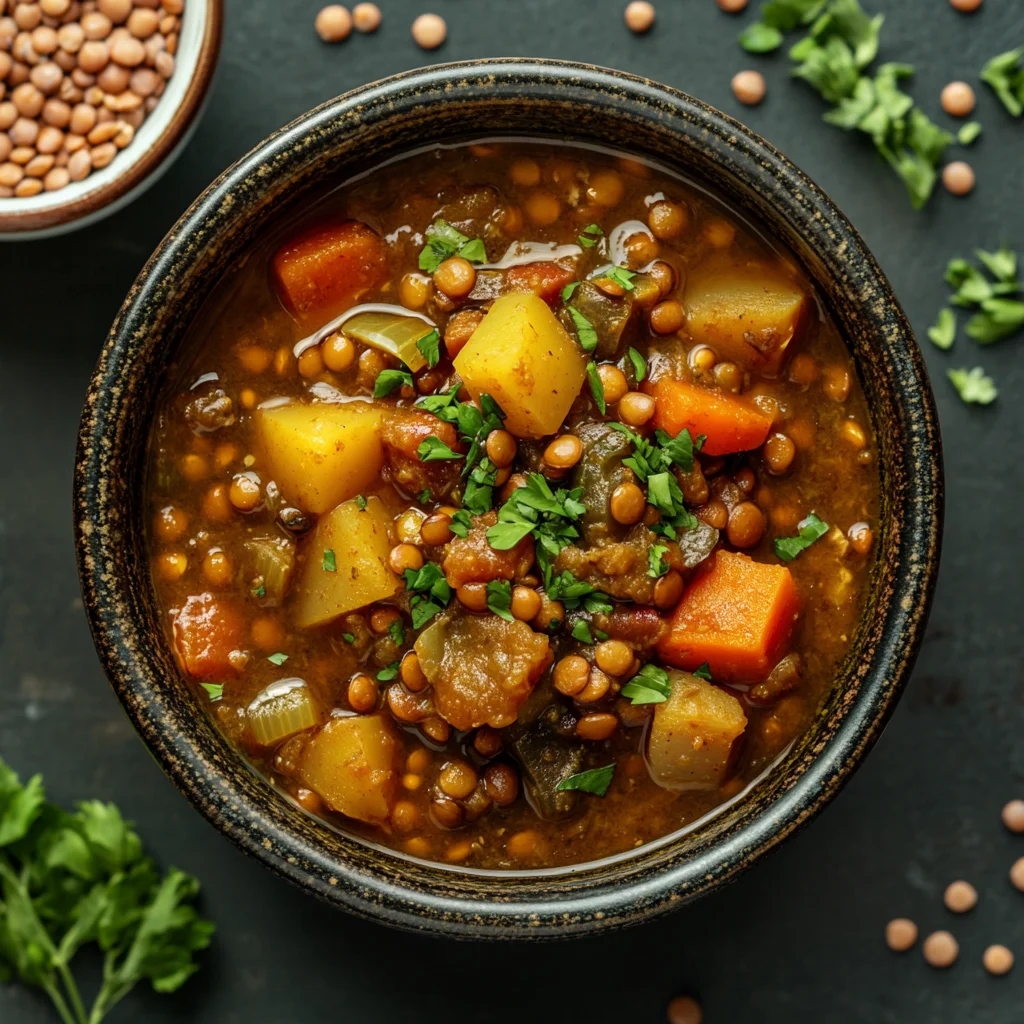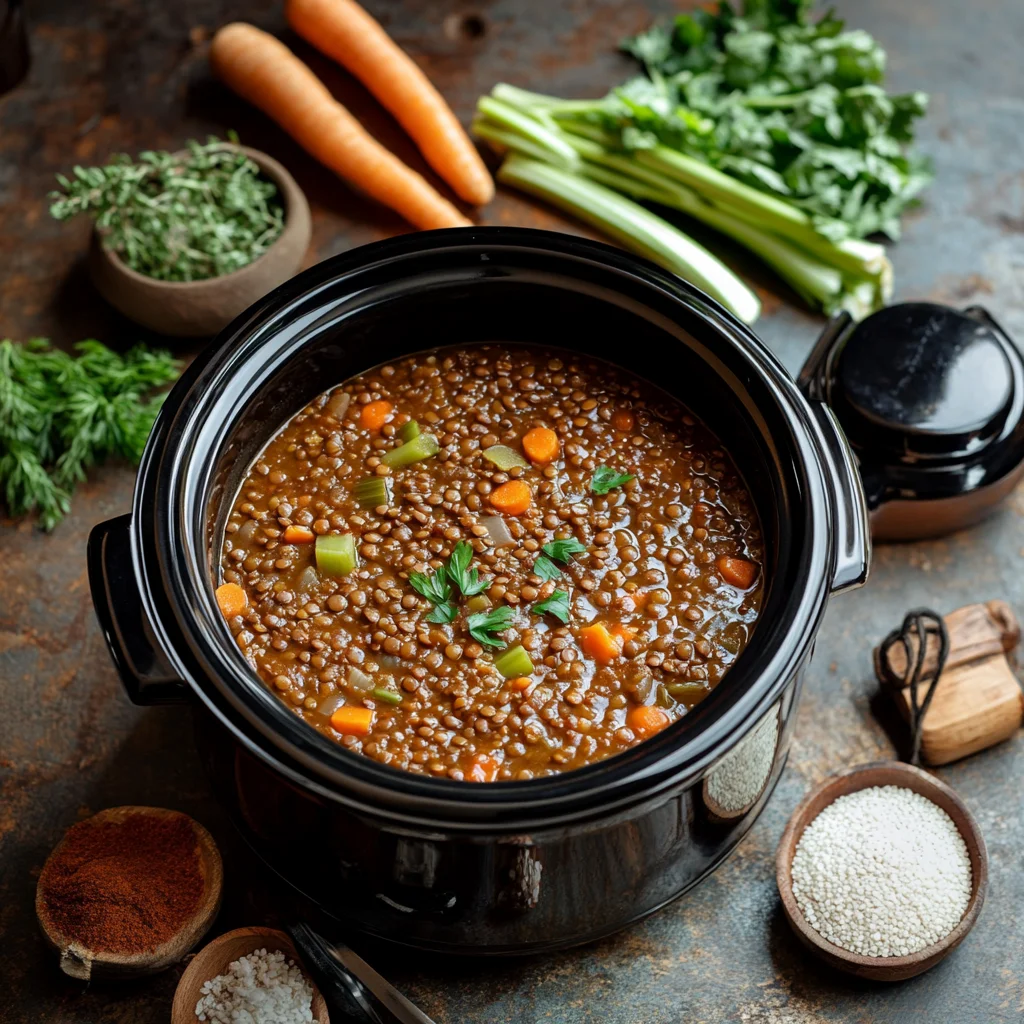Introduction
When it comes to comforting, nutritious, and budget-friendly meals, few dishes can match the charm of slow cooker lentil stew. This hearty recipe has been a staple in kitchens around the world, celebrated for its rich flavors and incredible versatility. Whether you’re looking for a warming winter meal or a protein-packed vegetarian option, lentil stew delivers.
What makes this dish even more appealing is the slow cooker. It transforms simple ingredients into a deeply satisfying meal with minimal effort. In this article, we’ll explore everything you need to know to prepare the perfect slow cooker lentil stew, from ingredient selection to serving ideas. Let’s dive into the art of crafting this wholesome classic.
The Basics of Lentil Stew
What Is Slow Cooker Lentil Stew?
Lentil stew is a thick, hearty dish made with lentils as the star ingredient, paired with a medley of vegetables, spices, and sometimes proteins like meat or plant-based alternatives. It is versatile and customizable, making it a favorite for home cooks worldwide. Typically, lentil stew is slow-cooked to allow the flavors to meld beautifully, resulting in a meal that’s both comforting and nutritious.
Nutritional Benefits of Lentils in a Slow Cooker Dish
Lentils are nutritional powerhouses, offering a wealth of benefits:
- Rich in Protein: Lentils are an excellent source of plant-based protein, making them ideal for vegetarians and vegans.
- High in Fiber: They support digestive health and help maintain a feeling of fullness.
- Packed with Essential Nutrients: Lentils provide iron, folate, magnesium, and potassium, contributing to energy and overall wellness.
- Low in Fat: This makes lentils a heart-healthy option for those watching their calorie intake.
Why a Slow Cooker Is Perfect for Lentil Stew
The slow cooker is the unsung hero of easy meal preparation. Here’s why it shines when making lentil stew:
- Convenience: With minimal prep and a “set-it-and-forget-it” approach, the slow cooker saves time and effort.
- Enhanced Flavor: Slow cooking allows the ingredients to blend harmoniously, enhancing the depth of flavor.
- Perfect Texture: Lentils cook evenly without becoming mushy, and the vegetables retain their shape and taste.
- Energy Efficiency: Slow cookers use less energy than ovens, making them a cost-effective option.
Choosing the Right Ingredients

The success of a slow cooker lentil stew depends heavily on the ingredients you choose. From the type of lentils to the seasoning, every element plays a critical role in crafting the perfect dish. Here’s how to make the best choices:
Best Lentils for a Slow Cooker Stew: Red, Green, or Brown?
Lentils come in various types, and each brings unique qualities to the stew. Here’s a quick guide to help you choose the right variety:
- Brown Lentils: The most common type, brown lentils hold their shape well and have an earthy flavor. They are ideal for a chunky stew with distinct textures.
- Green Lentils: Slightly firmer than brown lentils, green lentils have a peppery taste. They are perfect for recipes where a bit more bite is desired.
- Red or Yellow Lentils: These lentils cook quickly and tend to break down, creating a creamy texture. They are great for thick, velvety stews.
If you prefer a balanced texture, you can even mix two types of lentils in the same recipe.
Vegetables That Make Slow Cooker Lentil Stew Delicious
Vegetables are the backbone of a good lentil stew, contributing both flavor and essential nutrients. Some excellent choices include:
- Carrots: Add sweetness and color to the stew.
- Celery: Brings a mild, aromatic flavor that complements lentils well.
- Potatoes or Sweet Potatoes: Provide heartiness and absorb the stew’s flavors beautifully.
- Onions and Garlic: Essential for building a robust base flavor.
- Tomatoes: Whether canned, fresh, or as a paste, tomatoes add acidity and depth.
Feel free to get creative by including seasonal or leftover vegetables like zucchini, spinach, or kale for added variety.
Herbs and Spices to Enhance Your Lentil Stew Recipe
The seasoning is what sets an ordinary stew apart from an extraordinary one. Here are some must-have options:
- Herbs: Fresh or dried thyme, rosemary, bay leaves, or parsley add an aromatic touch.
- Spices: Cumin, coriander, smoked paprika, or turmeric can provide warmth and complexity.
- Salt and Pepper: These are the basics but should be added thoughtfully to enhance the dish’s natural flavors.
For those who enjoy a spicy kick, a dash of cayenne pepper or chili flakes can take the stew to the next level.
Adding Proteins to Your Lentil Stew: Meat or Plant-Based Options
To make the stew heartier, consider these add-ins:
- Meat: Diced chicken, beef chunks, or sausage can be added for a protein boost.
- Plant-Based Proteins: Chickpeas, tofu, or tempeh are excellent vegetarian options.
- Grains: Add quinoa, barley, or rice for extra texture and nutritional value.
These extras are entirely optional but can transform your stew into a one-pot meal tailored to your preferences.
Preparing the Stew

The preparation phase sets the foundation for a slow cooker lentil stew that is flavorful, hearty, and perfectly cooked. By following these tips, you can ensure a delicious result every time.
Prepping Ingredients for Slow Cooker Lentil Stew
Before assembling your stew, take some time to prepare the ingredients:
- Chop Vegetables Uniformly: Cut vegetables into similar-sized pieces to ensure even cooking. Larger chunks work well in slow cookers as they retain texture during the long cooking time.
- Rinse Lentils: Thoroughly rinse lentils under cold water to remove debris or dust. Unlike beans, lentils don’t require soaking, but cleaning them is essential.
- Measure Accurately: For consistency, measure your ingredients, particularly liquids like broth, as too much or too little can affect the stew’s texture.
How to Layer Ingredients in a Slow Cooker for Lentil Stew
Layering is a crucial step when using a slow cooker. The order of ingredients ensures they cook evenly and don’t over- or undercook.
- Base Layer: Start with hearty vegetables like carrots, celery, and potatoes since they take longer to cook. Place them at the bottom of the cooker.
- Middle Layer: Add the lentils, which will soak up the flavors of the broth and spices as they cook.
- Top Layer: Softer vegetables like spinach, kale, or zucchini should go on top since they require less time to cook.
- Liquids Last: Pour broth, water, or tomato-based liquids over the ingredients to evenly distribute moisture and flavor.
Avoid stirring everything at the beginning; it’s better to let the layers cook undisturbed to maintain structure and flavor.
Achieving the Perfect Texture in Your Slow Cooker Lentil Stew
The amount of liquid you add depends on your desired stew consistency. Keep these pointers in mind:
- For a Thick Stew: Use just enough liquid to cover the ingredients. Lentils will absorb a significant portion of the liquid as they cook.
- For a Soupier Texture: Add extra broth or water. You can always simmer the stew uncovered at the end to thicken it if needed.
Remember, it’s easier to adjust the consistency later than to fix an overly thin or watery stew.
Ideal Cooking Times for Lentil Stew in a Slow Cooker
One of the best things about a slow cooker is its flexibility. Depending on your schedule, you can choose a cooking time that works best:
- Low Heat: Cook for 6-8 hours. This setting allows the flavors to develop gradually and yields the most tender results.
- High Heat: Cook for 3-4 hours if you’re short on time. The stew will still taste great, but the flavors may not meld as deeply.
- Final Check: Stir the stew during the last hour of cooking to ensure everything is well combined and the lentils are fully cooked.
Pro Tip: Avoid removing the lid too often during cooking, as this releases heat and can extend the cooking time.
Enhancing the Recipe
Slow cooker lentil stew is a versatile dish that can be easily adapted to suit your taste preferences and dietary needs. Whether you want to make it vegan, add more richness, or create allergy-friendly options, there’s plenty of room for customization.
Vegan Variations of Slow Cooker Lentil Stew
For those who prefer a vegan or vegetarian version, lentils provide plenty of protein on their own. However, you can boost the protein content and texture by adding:
- Chickpeas: Their nutty flavor and firm texture complement lentils beautifully.
- Tofu or Tempeh: Cube and stir them in during the last hour of cooking to absorb the stew’s flavors.
- Mushrooms: Add a meaty texture and umami flavor.
- Edamame or Peas: For a touch of sweetness and an extra protein kick, stir these in during the final stages.
These additions make the stew more filling and flavorful without compromising its plant-based profile.
Add Sweetness or Spice to Your Lentil Stew Recipe
To elevate the flavor profile of your lentil stew, consider adding a hint of spice or sweetness:
- Heat: Sprinkle in chili flakes, cayenne pepper, or diced jalapeños for a spicy kick.
- Sweetness: A small amount of maple syrup, honey, or brown sugar can balance the dish’s earthiness, especially if you’ve included tomatoes.
Experimenting with these flavors allows you to tailor the stew to your liking, whether you enjoy bold, spicy notes or subtle sweetness.
Creamy Slow Cooker Lentil Stew: Tips and Tricks
If you prefer a creamier consistency, try these methods:
- Coconut Milk: Stir in a can of full-fat coconut milk during the last 30 minutes of cooking for a rich, velvety texture.
- Pureed Vegetables: Blend a portion of the cooked stew and mix it back in to thicken and smooth the texture.
- Dairy Additions: For non-vegan options, add a splash of heavy cream, plain yogurt, or grated cheese right before serving.
These additions can transform your stew into a luxurious dish while maintaining its hearty appeal.
Gluten-Free and Allergy-Friendly Slow Cooker Lentil Stew
Lentil stew is naturally gluten-free, but cross-contamination from certain ingredients might occur. To ensure it remains allergy-friendly:
- Choose Certified Gluten-Free Broth: Some store-bought broths may contain gluten-based thickeners.
- Avoid Common Allergens: Skip add-ins like nuts or dairy if cooking for those with allergies. Instead, opt for coconut milk or allergen-safe substitutes.
With these simple adjustments, your stew can cater to a variety of dietary restrictions without compromising on taste or nutrition.
Serving Suggestions

A well-prepared slow cooker lentil stew deserves equally thoughtful accompaniments. Serving it creatively can enhance the dining experience, turning a simple dish into a delightful meal.
Best Side Dishes for Lentil Stew
Pairing lentil stew with complementary side dishes elevates its appeal. Here are a few ideas:
- Crusty Bread: A warm, crusty loaf is perfect for dipping into the rich broth.
- Rice or Quinoa: Serve the stew over cooked rice, quinoa, or another grain for a heartier meal.
- Salads: A fresh side salad with crisp greens, cucumbers, and a light vinaigrette provides a refreshing contrast to the stew’s earthy flavors.
- Roasted Vegetables: Caramelized roasted vegetables like Brussels sprouts, carrots, or parsnips pair beautifully with the stew’s hearty base.
These sides add variety, ensuring the meal feels complete and balanced.
Garnishes to Add Visual Appeal and Extra Flavor
A garnish can do wonders for presentation and taste. Consider topping your lentil stew with:
- Fresh Herbs: Chopped parsley, cilantro, or dill for a burst of color and freshness.
- Yogurt or Sour Cream: A dollop adds creaminess and a tangy contrast.
- Crumbled Cheese: Feta, goat cheese, or Parmesan bring richness and depth.
- Toasted Nuts or Seeds: Add a crunchy texture with toasted almonds, sunflower seeds, or pumpkin seeds.
- Lemon or Lime Wedges: A squeeze of citrus brightens the dish and balances the flavors.
These simple touches can transform your stew from ordinary to extraordinary.
Storing and Reheating Leftovers
Lentil stew tastes even better the next day as the flavors continue to develop. Here’s how to store and reheat it:
- Storage:
- Allow the stew to cool to room temperature before transferring it to an airtight container.
- Store in the refrigerator for up to 5 days.
- For longer storage, freeze the stew in portion-sized containers for up to 3 months.
- Reheating:
- For the best texture, reheat the stew gently on the stovetop over low to medium heat.
- Add a splash of broth or water if it thickens too much during storage.
- If reheating from frozen, thaw the stew overnight in the refrigerator before warming it up.
These storage tips ensure you can enjoy the stew again without sacrificing its quality.
Health Benefits of Lentil Stew

Slow cooker lentil stew is not just a delicious comfort food; it’s also a nutritional powerhouse. Packed with essential nutrients, this dish supports overall health while being low in calories and high in flavor. Here are the key health benefits of incorporating lentil stew into your diet.
A Heart-Healthy Meal
Lentil stew is excellent for heart health due to its nutrient composition:
- Rich in Fiber: Soluble fiber in lentils helps reduce LDL cholesterol levels, which can lower the risk of heart disease.
- Low in Saturated Fat: A plant-based lentil stew naturally avoids the high saturated fat content found in many meat-based dishes.
- High in Potassium: Lentils and vegetables in the stew are rich in potassium, which helps regulate blood pressure and supports cardiovascular health.
Adding heart-healthy herbs like garlic and turmeric further enhances its benefits.
Supporting Digestive Health with Lentils
The fiber content in lentils plays a critical role in maintaining a healthy digestive system:
- Promotes Regularity: The high fiber content prevents constipation and promotes regular bowel movements.
- Supports Gut Health: Lentils act as a prebiotic, feeding beneficial gut bacteria and supporting overall digestive wellness.
- Gentle on the Stomach: Unlike some legumes, lentils are easier to digest, especially when cooked slowly, which reduces compounds that can cause bloating.
This makes lentil stew a gentle yet effective choice for improving digestive health.
Sustained Energy: High Protein and Fiber Content
Lentil stew provides lasting energy, making it ideal for busy days or active lifestyles:
- Plant-Based Protein: Lentils are an excellent source of protein, which is essential for muscle repair and growth.
- Complex Carbohydrates: Unlike refined carbs, the complex carbs in lentils release energy slowly, preventing spikes in blood sugar levels.
- Iron for Energy: Lentils are a great source of non-heme iron, which supports oxygen transport in the blood and prevents fatigue.
Pairing lentil stew with a source of vitamin C, like a side salad with citrus dressing, can enhance iron absorption.
Weight Management and Satiety
Lentil stew is a filling and low-calorie meal, making it a great choice for weight management:
- Low Glycemic Index: Lentils cause a gradual rise in blood sugar, helping control hunger and preventing overeating.
- High Satiety: The combination of protein and fiber helps you feel full for longer periods, reducing the likelihood of snacking between meals.
- Nutrient Density: Packed with vitamins and minerals, lentil stew provides nourishment without adding empty calories.
These qualities make lentil stew a smart addition to a balanced, weight-conscious diet.
Frequently Asked Questions (FAQs)
Lentil stew is a simple yet versatile dish, but some common questions may arise when preparing it in a slow cooker. Here are detailed answers to help you make the perfect lentil stew every time.
Can I Use Canned Lentils for Slow Cooker Stew?
Yes, you can use canned lentils in your stew, but they are already cooked, so they require a different approach:
- When to Add: Add canned lentils during the last 30 minutes of cooking to prevent them from becoming overly soft or mushy.
- Adjusting Liquid: Reduce the amount of liquid in the recipe slightly, as canned lentils do not absorb as much as dried lentils.
- Flavor Considerations: Rinse canned lentils thoroughly to remove any residual liquid, which might affect the taste.
While convenient, dried lentils are generally preferred for slow cooker recipes as they absorb flavors better during the long cooking process.
What Are the Best Substitutes for Lentils?
If you don’t have lentils on hand, you can use these alternatives:
- Split Peas: Similar in texture and flavor, split peas work well as a substitute.
- Chickpeas: Although firmer, they provide a satisfying bite and similar nutritional benefits.
- Black Beans or Kidney Beans: These can change the flavor slightly but offer a hearty and protein-rich alternative.
- Quinoa: While not a legume, quinoa can replace lentils for a unique twist on the stew.
Keep in mind that cooking times and liquid adjustments may vary depending on the substitute used.
How Long Can Lentil Stew Be Stored?
Proper storage ensures that your lentil stew remains fresh and safe to eat:
- Refrigerator: Store in an airtight container for up to 5 days.
- Freezer: Lentil stew freezes exceptionally well. Freeze in portion-sized containers for up to 3 months.
- Thawing: For best results, thaw frozen stew in the refrigerator overnight before reheating.
Always ensure the stew is reheated to an internal temperature of 165°F (74°C) to ensure it’s safe to consume.
Can I Freeze Lentil Stew?
Absolutely! Lentil stew is a freezer-friendly dish:
- Freezing Tips:
- Cool the stew completely before transferring it to freezer-safe containers or bags.
- Leave some room at the top of the container for expansion.
- Label with the date to keep track of freshness.
- Reheating: Heat the frozen stew on the stovetop or microwave, adding a splash of water or broth if it has thickened.
Freezing does not compromise the flavor or nutritional value, making it perfect for meal prep.
How Do I Adjust the Recipe for More or Fewer Servings?
Scaling a lentil stew recipe is straightforward:
- For More Servings:
- Double or triple the ingredients as needed.
- Ensure your slow cooker has enough capacity to accommodate the increased volume.
- For Fewer Servings:
- Halve the ingredients proportionally.
- Monitor the liquid levels carefully to prevent the stew from drying out.
Cooking times may remain the same, but it’s wise to check the stew’s consistency and doneness periodically.
Why Are Lentils Sometimes Undercooked in a Slow Cooker?
Undercooked lentils can be frustrating, but this issue is often easy to resolve:
- Causes:
- Insufficient cooking time: Lentils may require a full 6-8 hours on low heat to soften completely.
- Hard water: Minerals in hard water can prevent lentils from softening. Use filtered water or add a pinch of baking soda to the liquid.
- Acidic Ingredients: Ingredients like tomatoes or vinegar can slow the cooking process. Add them later in the cooking process if necessary.
- Solutions:
- Soak lentils briefly before cooking to speed up the process.
- Always check the lentils for doneness before serving.
Cozy Up with Slow Cooker Lentil Stew
Slow cooker lentil stew is the ultimate comfort food—hearty, nutritious, and packed with flavor. To make your meal even more satisfying, pair it with a side of warm bread or explore hearty recipes like Ground Beef Crock Pot Recipes for more slow-cooked inspiration. For a vibrant addition, serve alongside a tangy salad inspired by the flavors of Pickled Sausages. End the meal on a sweet note with Strawberry Bars, the perfect dessert to balance the richness of your stew.
Conclusion
Slow cooker lentil stew is more than just a meal; it’s a nourishing and versatile dish that fits perfectly into a variety of lifestyles and dietary preferences. With its ease of preparation, rich flavors, and impressive nutritional benefits, it’s no wonder this stew remains a favorite in kitchens worldwide.
Whether you’re preparing a hearty vegan dinner, a protein-packed family meal, or simply looking to batch-cook for the week, lentil stew delivers every time. The slow cooker enhances the dish by blending flavors beautifully while requiring minimal effort, leaving you free to focus on other tasks.
From selecting the best ingredients to adjusting the recipe to your taste, slow cooker lentil stew offers endless opportunities for customization. Its affordability, health benefits, and long shelf life make it a must-have recipe in your culinary repertoire. So why wait? Grab your slow cooker, and let this comforting classic bring warmth and joy to your table.

